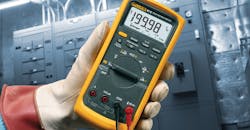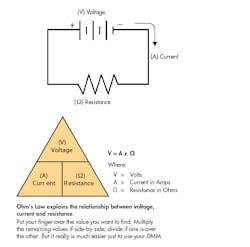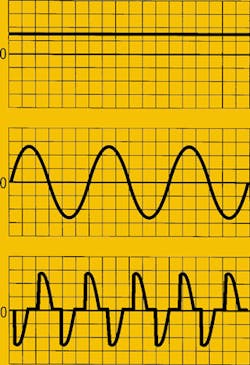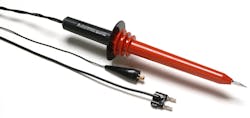Digital multimeters (DMM), once called voltmeters, have been described as the tape measure for engineers in the new millennium. With electronics and electrical circuits included in almost every consumer and industrial product, DMMs are a must for designing, testing, and troubleshooting.
Here’s a look at the features and capabilities of DMMs, as well as how to use them safely.
DMM Basics
DMMs are tools for measuring volts (V), ohms (Ω), and amperes (A). Most DMMs have other features and characteristics, but measuring these three variables is the foundation for all electrical measurements. You should also know the different ways DMMs display their measurements.
Resolution
Resolution refers to how fine a DMM’s measurement is. By knowing the meter’s resolution, you can determine if it's possible for it to see a small change in the measured signal. For example, if the DMM has a resolution of 1 mV on the 4V range, it can see a change of 1 mV (1/1,000 of a volt) while reading a 1V signal.
You wouldn’t buy a ruler marked in one-inch (or one-centimeter) segments if you had to measure down to a quarter inch (or one millimeter). A thermometer that measures only in whole degrees isn’t much use when your normal temperature is 98.6°F. You need a thermometer with a one-tenth-degree resolution.
Accuracy
Accuracy is the largest allowable error under specific operating conditions. In other words, it's an indication of how close the DMM’s measurement is to the actual value of the signal. Accuracy for DMMs is usually expressed as a percent of the reading. An accuracy of 1% of the reading means that for a displayed reading of 100V, the actual value of the voltage could be anywhere between 99 and 101V.
Digital and Analog Displays
For high accuracy and resolution, a digital display shows three or more digits for each measurement. The analog needle display is less accurate and has a lower effective resolution because you have to estimate values between the lines. A bar graph shows signal changes and trends just like an analog needle but is more durable and less prone to damage.
Analog meter specifications are determined by the error at full scale, not at the displayed reading. Typical accuracy for an analog meter is ±2% or ±3% of full scale. At one-tenth of full scale, these become 20 or 30% of the reading. Typical basic accuracy for a DMM is between ±0.7% and ±0.1% of the reading, or better.
Saving and Sharing Results
As equipment has become more complex and more powerful, so have DMMs. Wireless test tools can send results to each other and to smartphones, where you can share data, images, and notes with colleagues. Wireless DMMs, other related test tools, and smartphone apps (such as Fluke Connect) let engineers make the best decisions faster than ever before, saving time and increasing productivity.
Measuring DC and AC Voltage
One basic task of a DMM is measuring voltage. A typical DC voltage source is a battery, such as the ones used in cars. AC voltage is usually created by a generator. The wall outlets in your home are common sources of AC voltage.
Some devices convert AC to DC.
For example, electronic equipment such as TVs, stereos, VCRs, and computers you plug into an AC wall outlet use devices called rectifiers to convert AC voltage into DC voltage. This DC voltage is what powers electronic circuits in these devices.
Testing for proper supply voltage is usually the first step when troubleshooting a circuit. If there's no voltage present, or if it's too high or too low, the voltage problem should be corrected before investigating further.
The waveforms associated with AC voltages are either sinusoidal (sine waves), or non-sinusoidal (sawtooth, square, and ripple, for example.). True-RMS DMMs display the “RMS” (root mean square) value of these voltage waveforms. The RMS value is the effective or equivalent DC value of an AC voltage.
Some basic DMMs are “average responding,” giving accurate RMS readings if the AC voltage signal is a pure sine wave. Average responding meters cannot accurately measure non-sinusoidal signals. Non-sinusoidal signals are accurately measured using DMMs designated “true-RMS” up to the DMM’s specified crest factor. A crest factor is the ratio of a signal’s peak-to-RMS value. It’s 1.414 for a pure sine wave, but is often much higher for a rectifier current pulse, for example.
As a result, average responding meters will often read much lower than the actual RMS value. But most meters are true RMS these days.
A DMM’s ability to measure AC voltage can be limited by the signal’s frequency. Most DMMs accurately measure AC voltages with frequencies from 50 to 500 Hz, but a DMM’s AC measurement bandwidth can be hundreds of kilohertz wide. Such a meter reads a higher value because it “sees” more complex AC signals.
DMM accuracy specifications for AC voltage and AC current should give a frequency range along with the range’s accuracy.
How to Take Voltage Measurements
Taking a voltage measurement is simple:
- Select "V".
- Plug the black test probe into the "COM" input jack. Plug the red test probe into the "V" input jack.
- If the DMM only has manual ranging, select the highest range so as not to overload the input.
- Touch the probe tips to the circuit across a load or power source (in parallel to the circuit).
- View the reading, being sure to note the unit of measurement.
Be careful. For DC voltage readings of the correct polarity, touch the black probe to the negative side of the circuit ground, and the red probe to the positive side of the circuit. If this gets reversed, a DMM with autopolarity will merely display a minus sign indicating negative polarity. With an analog meter, however, you risk damaging the meter.
Resistance, Continuity, and Diodes
Resistance
Resistance is measured in ohms (Ω). Resistance values can vary greatly, from a few milliohms (mΩ) for contact resistance to billions of ohms for insulators. Most DMMs measure down to 0.1 Ω and some measure as high as 300 MΩ. (300,000,000 ohms). Infinite resistances (open circuits) are read as “OL” on many meter displays and means the resistance exceeds the meter-measuring capability.
Resistance measurements must be made with the circuit power off; otherwise, the meter or circuit could be damaged. Some DMMs provide protection in the ohms mode in case of accidental contact with voltages. The level of protection varies greatly among different DMMs.
For accurate, low-resistance measurements, resistance in the test leads must be subtracted from the total resistance measured. Typical test lead resistance falls between 0.2 and 0.5 Ω. If test-lead resistance exceeds 1 Ω, they should be replaced.
If the DMM supplies less than 0.6V DC test voltage for measuring resistance, it will be able to measure the values of resistors that are isolated in a circuit by diodes or semiconductor junctions. This often allows users to test resistors on circuit boards without unsoldering them.
How to Measure Resistances
- Turn off the power to the circuit.
- Select resistance (Ω).
- Plug the black test probe into the "COM" input jack. Plug the red test probe into the "Ω" input jack.
- Connect the probe tips across the component or portion of the circuit for which you want to determine resistance.
- View the reading, being sure to note the unit of measurement—ohms (Ω), kilohms (kΩ) or megohms (MΩ).
Continuity
Continuity is a quick go/no-go resistance test that distinguishes between open and closed circuits. A DMM with a continuity beeper lets users do many continuity tests easily and quickly. The meter beeps when it detects a closed circuit, so there’s no need to look at the meter while testing. The resistance required to trigger the beeper varies from model to model of DMM.
Diodes
Diodes are like electronic switches and will turn on if the voltage exceeds a certain level—generally about 0.6V for a silicon diode—and when switched on, lets current flow in only one direction.
Many DMMs have a diode test mode. This mode measures and displays the actual voltage drop across a junction. A silicon junction should have a voltage drop of less than 0.7V when applied in the forward direction and an open circuit in the reverse direction. Be cautious when using an analog volt-ohm meter to test a diode or transistor junction. These meters can drive currents up to 50 mA through the junction, potentially damaging the unit under test.
DC and AC Current
Current measurements differ from other DMM measurements. Current measurements taken with a DMM using test leads (not using a current clamp—more on that later) require placing the meter in series with the circuit being measured. This means opening the circuit and letting the DMM test leads complete the circuit. This way all circuit current flows through the DMM.
How to Take Current Measurements
- Turn off the power to the circuit.
- Cut or unsolder the circuit, creating a place where the meter probes can be inserted.
- Select A (AC) or A (DC) as desired.
- Plug the black test probe into the "COM" input jack. Plug the red test probe into the amp or milliamp input jack, depending on the reading’s expected value.
- Connect the probe tips to the circuit across the break so that all current will flow through the DMM (a series connection).
- Turn the circuit power back on.
- View the reading, being sure to note the unit of measurement. If the test leads are reversed for a DC measurement, a “–” will show in the display.
Input Protection
A common mistake is to leave the test leads plugged into the current input jacks and then try to measure voltage. This causes a direct short across the source voltage through a low-value resistor (aka current shunt) inside the DMM. A high current flows through the DMM, and if the meter is not adequately protected, the current can damage both the DMM and circuit, and possibly injure the user. Fault currents can be extremely high if industrial high-voltage (240V or higher) circuits are involved.
DMMs should therefore have current-input fuse protection of high enough capacity for the circuit being measured. Meters without this fuse protection should not be used on high-energy (> 240V AC) circuits. DMMs that use fuses should have a fuse with enough capacity to clear high-energy faults. The voltage rating of the meter’s fuses should exceed the maximum voltage a user expects to measure.
For example, a 20 A, 250V fuse may not be able to clear a fault inside the meter when the meter is across a 480V circuit. It would take a 20 A, 600V fuse to clear the fault on that circuit.
There are two basic types of protection circuits, those with automatic recovery and those without it. Some meters have circuitry that detects overloads and protects the meter until the condition no longer exists. After the overload is removed, the DMM returns itself to normal operation. This is usually used to protect the ohms function from voltage overloads. Other meters detect overloads and protect the meter but will not recover until the operator performs an operation on the meter, such as replacing a fuse.
Current Probe Accessories
Sometimes users must measure currents that exceed the DMM’s rating, or else they find themselves in situations that do not let them open the circuit to measure the current. In these higher current applications (typically over 2 A) where high accuracy is not needed, a current probe can be useful. A current probe clamps around the conductor carrying the current and converts the measured value to a level the meter can handle.
Current probes (which are actually current transformers) measure AC current only. The output of a current transformer is typically 1 milliamp per amp. So a 100 amp value becomes 100 milliamps, which can be safely measured by most DMMs. Probe leads are connected to the “mA” and “COM” input jacks, and the meter function switch is set to mA AC.
Multimeter Safety
Making measurements safely starts with choosing the proper meter for the task as well as the environment in which the meter will be used. Users should read and follow the user manual before use, paying particular attention to WARNING and CAUTION sections.
Make sure you use a meter that meets the International Electrotechnical Commission’s (IEC) category and voltage rating approved for where the measurement is to be made. For instance, if a voltage measurement needs to be made in an electrical panel with 480V, then a meter rated Category III 600V or 1,000V should be used. This means the input circuitry of the meter will withstand voltage transients commonly found in this environment without harming the user.
Choosing a meter with this rating which also has a UL, CSA, VDE, or TUV certification means the meter not only meets IEC standards but has been independently tested to show it meets those standards.
But how can someone know if they have a genuine CAT III or CAT II meter? It’s not always easy. It is possible for manufacturers to self-certify their meters as CAT II or CAT III without independent verification. Beware of wording such as “Designed to meet specifications...” Designer’s plans are never a substitute for actual independent testing. The IEC develops and proposes standards, but it is not responsible for enforcing the standards.
Look for the symbol and listing number of an independent testing lab such as CE, CSA, RCM, or other recognized approval agency. That symbol can only be used if the DMM successfully completed testing to the agency’s standard, which is based on national/international standards. UL 61010, for example, is based on IEC 61010. In an imperfect world, that is the closest you can come to ensuring the multimeter was actually tested for safety.
Keep away From Dangerous Panels
Your DMM can also protect you by keeping you away from hazardous situations. DMMs that communicate wirelessly with personal computers, smartphones, and other wireless test tools can be placed safely inside electrical panels with the power shut off. When the panel is closed and reenergized, measurements can be made remotely, saved, and shared, all without putting yourself in front of a live electrical panel.
Measurement Categories
A critically important concept to understand about electrical safety is the measurement category, mentioned briefly above. Standards define Categories 0 through IV, often abbreviated as CAT 0, CAT II, etc. The division of a power distribution system into categories is based on the fact that a dangerous high-energy transient such as a lightning strike will be attenuated or dampened as it travels through the impedance (AC resistance) of the system. A higher CAT number refers to an electrical environment with higher power available and higher energy transients. Thus a multimeter designed to a CAT III standard is resistant to much higher energy transients than one designed to CAT II standards.
Within a category, a higher voltage rating denotes a higher transient withstand rating—e.g., a CAT III 1,000V meter has superior protection compared to a CAT III 600V-rated meter. The real misunderstanding occurs if someone selects a CAT II 1,000V-rated meter.
Safety Checklist
- Use a meter that meets accepted safety standards for the environment in which it will be used.
- Use a meter with fused current inputs and be sure to check the fuses before making current measurements.
- Inspect test leads for physical damage before making a measurement.
- Use the meter to check the continuity of the test leads.
- Use only test leads that have shrouded connectors and finger guards.
- Use only meters with recessed input jacks.
- Select the proper function and range for your measurement.
- Be certain the meter is in good operating condition.
- Follow all equipment safety procedures.
- Always disconnect the “hot” (red) test lead first.
- Don’t work alone.
- Use a meter that has overload protection on the ohms function.
- When measuring current without a current clamp, turn the power off before connecting to the circuit.
- Be aware of high-current and high-voltage situations and use the appropriate equipment, such as high-voltage probes and high-current clamps.
Special Features
The following special features and functions may make it easier to use your DMM.
- Annunciators show at a glance what is being measured (volts, ohms, etc.).
- One-switch operation makes it easy to select measurement functions.
- Overload protection prevents damage to both the meter and the circuit while protecting the user.
- Special high-energy fuses provide extra protection for the user and meter during current measurements and overloads.
- Autoranging automatically selects the proper measurement range. Manual ranging lets you lock into a specific range for repetitive measurements.
- Autopolarity indicates negative readings with a minus sign, so even if you connect the test leads in reverse you won’t damage the meter.
- Low battery indicator.
Fluke DMMs are used for examples in this article. Other DMMs may operate differently or offer different features from the ones shown. However, this article explains common uses and tips for using most DMMs.
About the Author
Sean Silvey
Product Application Specialist, Fluke Corporation
Sean Silvey is a product application specialist at Fluke. Previously, he was a residential/commercial HVAC technician and a field service manager. Sean’s focus is application awareness, product education, and safety.






